Page 1
2
3
4
5
6
7
8
9
10
11
Saturday, 10 April.
After checking out of the hotel, we drove into downtown Trieste where we had
breakfast at a bar. (In Italy a bar serves mostly coffee.) Someone, who shall be
nameless, spilled her cafe latte. It made a tremendous mess, but the bar
employees were very nice about it. We drove along the waterfront, around the
Piazza Unita d'Italia, then up Castle Hill overlooking the city. There we
explored the San Giusto Castle (15-17th century) and saw the mixed-style San
Giusto Basilica.
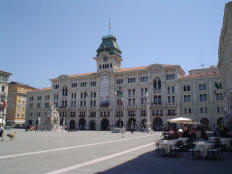
Piazza Unita d'Italia |

San Giusto Castle |
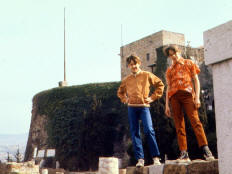
Randall & Kevin at San Giusto Castle |
We then headed for the Yugoslav border. It was crowded with
Italians going in for the weekend. The border guards just gave everyone a very
cursory check - until they got to us. Apparently they didn't see many American
military families. We were pulled over to the side while our passports went into
the office. I followed them after a while and found an official paging
through a huge ledger, apparently looking to see if our names were listed.
Eventually he cleared us. Then the customs police opened our trunk but
fortunately did not unload everything. Incidentally, no one at the border spoke
English, but they almost all knew Italian.
I then bought 400 liters of gas coupons (at 50 cents a
gallon, half what we expected to pay). I also changed some money, and we were
on our way. Unfortunately, we didn't know where to because there had been no
road signs for miles.
We decided to take the highway across the neck of the Istrian
Peninsula, rather than the much longer route along the coast. Although I
had read about the karst-covered land, the rocky, hilly countryside came as a
somewhat of a surprise since we expected it to be fairly lush, like Italy.
(Karst is a peculiar type of limestone, all split into narrow layers, almost
like cut stone.) It was really quite desolate. We got many
impressions during our first couple of hours of driving in Yugoslavia, many of
which were reinforced many times over the next week.
We saw people walking along the road where there wasn't a
building visible for miles in any direction, so they must have been going a very
long way. That is rare in western Europe where there are villages every few
kilometers, and even the poor have their bicycles. The wagons and plows we saw
were drawn by oxen or small horses, never by tractors. That was not unusual
during our tour in Italy ten years earlier, but it was not common in 1971. We
saw a woman pulling a wagon only slightly smaller than those pulled by draft
animals, all the more surprising because the road was so hilly. In spite of the
poor appearance of the entire area, the rocky hills were carefully terraced and
seemed to be cultivated.

Trsat Castle
|
As we reached the other side of the peninsula, we found
ourselves on a road high above the Opatija Riviera with a magnificent view of
the Adriatic coast. A short time later, we reached Rijeka (Fiume). We could see
the Trsat (Gradina), the old Frankopan citadel on the hill above the city. It
dates from pre-Roman times but has been destroyed and rebuilt several times.

Russian ship in Rijeka harbor |
The main point of interest for the boys turned out to be the
harbor, filled with Russian ships, each sporting a large red star on its
superstructure. The road ran along the edge of the harbor as it climbed a steep
hill, so we were very close to the ships, first near the water level and
eventually looking down onto the decks. At the boys urging, I made a U-turn and drove back past the ships so Dennis could take some pictures.
As we
continued south, the land was still rocky and hilly, but now there was the
Adriatic, with an occasional coastal town and numerous islands, on our right.
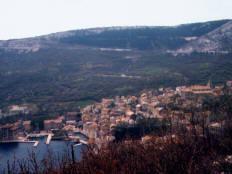
Karlobag from the highway |

Inlet near Karlobag |
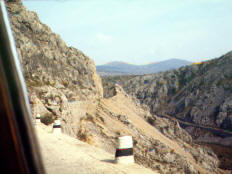
Driving through the karst |
The road hugged the coast, winding right to the end of every
spit of land, then left to the deepest point of every inlet. There was never a
straight stretch, and I was pushing it if I even reached 35 mph.
Consequently, we were surprised as we came around one particularly sharp turn to
find two policemen waving us down. Speaking in broken German, one of them said
we'd been speeding and had to pay a fine of 100 dinars ($15). I gave him
the money, but we doubted it ever got to the government.
We stopped for lunch at Crikvenica, a modern-looking beach
resort. We found a very nice restaurant, remembered for two humorous incidents.
The first was Jane's learning the Serbo-Croat word for beer (pivo) when I
corrected her statement that there was no possible word association to remember
it. The second was the infamous "omelet incident" in which I kept
remarking how I wasn't hungry, unsuccessfully tried to give away half of my
two-part omelet, and finally ate all of it myself, only to discover that I'd
eaten Jane's as well as my own. She was so busy working on a huge Waldorf salad
(three whole apples, whipped cream and nuts) that she didn't notice until it was
too late.
Still chuckling, we drove on through Senj with the 16th century Fortress of Nehaj overlooking it. The land became
even more barren. We saw a group of about ten men tilling one of the few arable
places with short-handled hoes. Soon after, there was no arable land - in fact,
no land at all, only karst. As we drove along, it got worse and worse until,
when the Adriatic was out of sight, it was like driving on the moon.
There would be no sign of life for miles at a time. At one such
desolate place, there was a young girl, about 12, standing in the road waiving
us down. Thinking she might be in trouble, we stopped. However, when she came up
to the car window, she held out her hand and said "dinar, dinar."
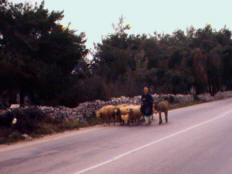
Shepherdess along the road in Dalmatia |
After driving along for hours through the karst with the water
on our right, we crossed a bridge and, all of a sudden, the water was on the
left. This was very confusing, especially since the endless curves as we
followed the coast created the feeling that we were going around and around one
big island. It turned out, on checking the map, that there was a large bay on
the left just as we lost sight of the sea on the right.
This was the beginning of Dalmatia,, and there was a
dramatic improvement in the quality of the land. It was still rocky, but there
were olive trees and grass. We also saw a few garden tractors in use, quite an
improvement on using hoes, but still no riding tractors.
Shortly after, we came into the city of Zadar, home of the "only
true maraschino." We had great difficulty getting directions to the hotel we
were looking for because no one understood English, Italian or German. An
Italian-speaking gentleman finally told us how to get to the Borik Peninsula
where the new hotels were. The Novi Park, with heated indoor swimming pool, was
full, but the Hotel Barbara, right across the parking lot, had plenty of rooms
and shared the Novi Park's pool and dining room. Each of our three double rooms
with bath was $6.00, including breakfast.
We had dinner at the Novi Park, and it was crowded with hundreds
of people. The service was quite good, even so. A combo started playing during
dinner, and I remarked that I never thought I'd find myself in a hotel
in Zadar, Yugoslavia, listening to the gentle strains of "Stars Fell on
Alabama."
Page 1
2
3
4
5
6
7
8
9
10
11[public_html/Travels/borderbottom.htm] |